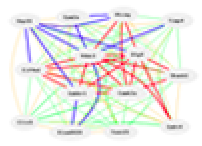

|

|

|
| | | | | | | | | | Welcome! Login |
Data Set Group2: CRTD BXD Hippocampal Precursor Cells ILM MouseWG-6_R13 (Dec14) Quantile
|
|
|
| Specifics of this Data Set: |
| None |
| Summary: |
| This data set was generated from proliferating adherent cultures of adult hippocampus-derived precursor cells from 20 BXD strains. The dentate gyrus of the mouse hippocampus is the site of continued neural precursor proliferation and generation of new neurons in adulthood as a distinct process from the widespread embryonic and juvenile neurogenesis during development. Adult-derived precursors can be isolated and maintained in adherent culture (Babu et al., 2007, 2011) and can be differentiated into neurons, astrocytes and oligodendrocytes. In this study, cultures were established from 20 BXD strains obtained through the authors’ involvement in the GeNeSys Consortium. This data set was obtained from cultures actively proliferating in the presence of growth factors. |
| About the cases used to generate this set of data: |
| The BXD genetic reference panel of recombinant inbred strains consists of just over 80 strains. The BXDs in this data set include 8 of the BXD strains made by Benjamin Taylor at the Jackson Laboratory in the 1970s and 1990s (BXD1 through BXD42). All of these strains are fully inbred, many well beyond the 100th filial (F) generation of inbreeding. We have also included 10 inbred (F20+) BXD lines generated by Lu and Peirce. In addition, the parental strains C57BL/6J and DBA/2J were used to yield a total of 20 genetically unique cell lines. All of these strains have been genotyped at 13,377 SNPs. |
| About the tissue used to generate this set of data: |
| The mice used in this study were bred at Harlan () for the GeNeSys Consortium and were delivered to the study site in Dresden at c. 6 weeks of age. Some animals were the 1st generation offspring of the Harlan stock which were bred and raised locally at the CRTD (housed at the Medizinisch-Theoretisches Zentrum of the Technische Universität Dresden). Animals were killed the day after delivery (or at 6 weeks of age if locally bred) and the hippocampi dissected and processed for precursor cell culture (Babu et al., 2011). Proliferating cultures were maintained in the presence of EGF and FGF-2 and passaged every 3-4 days. For microarray analysis, c. 1 million cells were harvested by on-plate lysis and total RNA prepared using the RNEasy mini kit (Qiagen) following the manufacturer’s protocol (including optional on-column DNase treatment). Each strain was assayed in triplicate (from 3 different passages). |
| About the array platform: |
| Illumina MouseWG-6 array with custom probe mapping: This data set uses a custom mapping of probes to Entrez GeneIDs. Each probe sequence on the MouseWG-6 v. 2.0 array was queried against the mm9 mouse genome using Jim Kent's BLAT program. The genomic position of probes returning a single hit was then used to assign the probe to an NCBI Entrez GeneID. Probes targeting the same GeneID were collapsed as means to yield data for 21155 unique genes. |
| About data values and data processing: |
| Raw data were preprocessed with quantile normalisation in R/Bioconductor using the package beadarray. After probe reannotation, data from probes targeting the same GeneID were collapsed as means. This results in a single unique probe set associated with each of the Entrez GeneIDs covered. |
| Notes: |
| This study is associated with the following records from the BXD Phenotype Database: 17347, 17348, 17349 |
| Experiment Type: |
| Each culture was derived from between 6 and 12 mice of c. 6 weeks old and of mixed sexes. Sex ratios in each batch varied. Triplicate cultures, from the same line but of different passage numbers, were used for RNA collection. Quantile normalisation of probe-level values was performed, and data for all probes mapping to the same Entrez GeneID were merged as means. No further adjustment of the data was done. |
| Contributor: |
| Gerd Kempermann CRTD – Center for Regenerative Therapies Dresden Technische Universität Dresden 01307 Dresden Germany |
| Citation: |
| Please cite: Kannan S, Nicola Z, Overall RW, Ichwan M, Ramírez-Rodríguez G, Grzyb A, Patone G, Saar K, Hübner N, Kempermann G (2016). Systems Genetics Analysis of a Recombinant Inbred Mouse Cell Culture Panel Reveals Wnt Pathway Member Lrp6 as a Regulator of Adult Hippocampal Precursor Cell Proliferation. Stem Cells 34(3):674–84. PMID: 26840599. |
| Data source acknowledgment: |
| Financial support covering the breeding and supply of BXD mice was provided by the Helmholtz Virtual Institute GENESYS (German Network of Systems Genetics, VH-VI-242) |
| Study Id: |
| 240 |

|
Web services initiated January, 1994 as Portable Dictionary of the Mouse Genome; June 15, 2001 as WebQTL; and Jan 5, 2005 as GeneNetwork. This site is currently operated by Rob Williams, Pjotr Prins, Zachary Sloan, Arthur Centeno. Design and code by Pjotr Prins, Zach Sloan, Arthur Centeno, Danny Arends, Christian Fischer, Sam Ockman, Lei Yan, Xiaodong Zhou, Christian Fernandez, Ning Liu, Rudi Alberts, Elissa Chesler, Sujoy Roy, Evan G. Williams, Alexander G. Williams, Kenneth Manly, Jintao Wang, and Robert W. Williams, colleagues. |

|

|
GeneNetwork support from:
|
|||
| It took 0.010 second(s) for tux01.uthsc.edu to generate this page | |||
